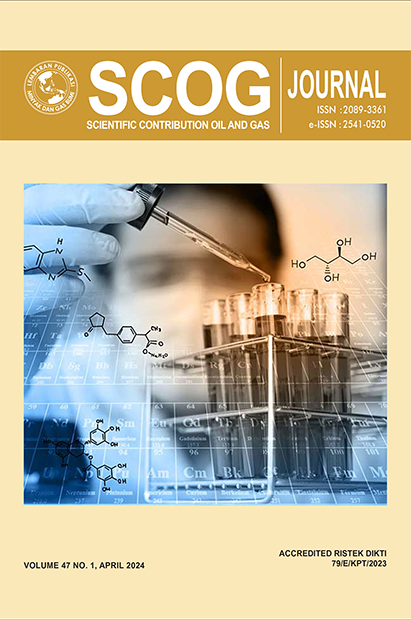Modeling The Distribution of Wastewater and Determining Zone of Initial Dilution from Waste Discharge Into The Sea From Fuel Terminal Activities in Balikpapan Bay
DOI:
https://doi.org/10.29017/SCOG.47.2.1623Keywords:
wastewater, fuel terminal, environmental modeling, balikpapan bayAbstract
Sea water quality in Balikpapan Bay is determined by two driving factors: river flow and sea tides. This study aimed to conduct predictive modeling of wastewater distribution from industrial activities with the potential for seawater pollution, specifically for fuel terminals in Balik Papan Bay. The data source used was primary data for the initial environmental baseline, which was taken from the results of the analysis of 1 liter sample each from the wastewater treatment outlet, outfall, and three points representing three sea areas receiving wastewater, and secondary data obtained from the Badan Informasi Geospatial (BIG) and ECWMF (European Center for Medium-Range Weather Forecasts). The tidal data obtained were analyzed using the least-squares method. The results of the wastewater distribution model showed that all parameters, including pH, TSS, BOD, COD, ammonia, fatty oil, salinity, TOC, and Total coliforms, met seawater quality standards both at high and low tide conditions in the West and East Monsoon based on Government Regulation No.22 of 2021 concerning the Implementation of Environmental Protection and Management Appendix VIII for ports
References
Abuhasel, K., Kchaou, M., Alquraish, M., Munusamy, Y., & Jeng, Y. T., 2021, Oilywastewater treatment: Overview of conventional and modern methods, challenges, and future opportunities, Water (Switzerland), 13(7). https://doi.org/10.3390/w13070980
Adetunji, A. I., & Olaniran, A. O., 2021, Treatment of industrial oily wastewater by advanced technologies: a review, In Applied Water Science (Vol. 11, Issue 6), Springer Science and Business Media Deutschland GmbH. https://doi.org/10.1007/s13201-021-01430-4
Ainuddin, and Muhammad Adam Suryadilaga, 2021, Oil and Gas in the Dynamics of Time and Development, Scientific Contributions Oil and Gas, 44 (2) pp., 153-159.
Hanim, A., Azam, M., Hidayanto, E., & Nuraini, E., 2012, Penentuan Kandungan Unsur Aluminium, Mangan dan Silikon dalam Air Sungai Code Terhadap Waktu Sampling dengan Metode AANC, BERKALA FISIKA, 10(1), 25-30.
Herlin Arina and Mohammad Nasikin, 2022, Enhancement of Flow Properties Biodiesel Using Sorbitan Monooleate, Scientific Contributions Oil and Gas, 45 (3) pp., 143-152. https://doi.org/10.23327/SCOG.45.2.34232.
Lareno, B., 2015, Analisa Dan Perbandingan Akurasi Model Prediksi Rentet Waktu Arus Lalu Lintas Jangka Pendek, CSRID (Computer Science Research and Its Development Journal), 6(3), 148. https://doi.org/10.22303/csrid.6.3.2014.148-158
Kidung, B. W., Elis, I., dan Indra, B. P., 2012, Kajian Pola Arus Perairan Teluk Lampung Menggunakan Pendekatan Model Hidrodinamika 2-Dimensi DELFT 3D, JOURNAL OF OCEANOGRAPHY. Volume 1, Nomor 2, Tahun 2012, Halaman 170
Abdurrojaq, N., Zaelani, R., Haley, B. A., Fathurrahman, N. A., Anggarani, R., Wibowo, C. S., Maymuchar, 2022, The Effect of Methanol-Gasoline (M20) And Ethanol-Gasoline (E20) Blends on Material Compatibility, Scientific Contributions Oil and Gas, 45 (2) pp., 87-94. https:// doi.org/10.29017/SCOG.45.2.966
Octaferina, A. R., & Prasetya, F. V. A. S., 2021, Kajian Karakteristik Pasang Surut Di Perairan Teluk Balikpapan Menggunakan Metode Admiralty, Buletin Poltanesa, 22(1). https://doi.org/10.51967/tanesa.v22i1.474
Petroleum Industry Wastewater Advanced and Sustainable Treatment Methods. (n.d.).
Panda, U.S., Mahanty, M.M., Rao, V.R., Patra, S., dan Mishra, P., 2015, Hydrodynamics and Water Quality in Chilika Lagoon - A Modelling Approach, 8th International Conference on Asian and Pacific Coasts (APAC 2015), Jurnal Procedia Engineering No.116, hal. 639-646.
Purwanto, E., Adrianto, L., & Rahardjo, S., 2017, Strategi Optimal Peningkatkan Efisiensi di Terminal Bahan Bakar Minyak (TBBM) Makassar dengan Menggunakan Discrete-Event Simulation, Warta Penelitian Perhubungan, 29(1), 33. https://doi.org/10.25104/warlit.v29i1.316
Wardhana, G. S., Pakpahan, H. J., Simarmata, K., Pranowo, W., Purba, H., 2021, Algoritma Komputasi Machine Learning untuk Aplikasi Prediksi Nilai Total Organic Carbon (TOC), Lembaran Publikasi Minyak dan Gas Bumi, 55 (2) pp., 75-87.
Yusuf, A., & Tjandrasa, H., 2013, Prediksi Nilai Dengan Metode Spectral Clustering Dan Clusterwise Regression. Jurnal Simatec, VIII(1), 39–45.
Downloads
Published
Issue
Section
License
Copyright (c) 2024 SCIENTIFIC CONTRIBUTIONS OIL AND GAS (SCOG)

This work is licensed under a Creative Commons Attribution 4.0 International License.
Authors are free to Share — copy and redistribute the material in any medium or format for any purpose, even commercially Adapt — remix, transform, and build upon the material for any purpose, even commercially.
The licensor cannot revoke these freedoms as long as you follow the license terms, under the following terms Attribution — You must give appropriate credit , provide a link to the license, and indicate if changes were made . You may do so in any reasonable manner, but not in any way that suggests the licensor endorses you or your use.
No additional restrictions — You may not apply legal terms or technological measures that legally restrict others from doing anything the license permits.














